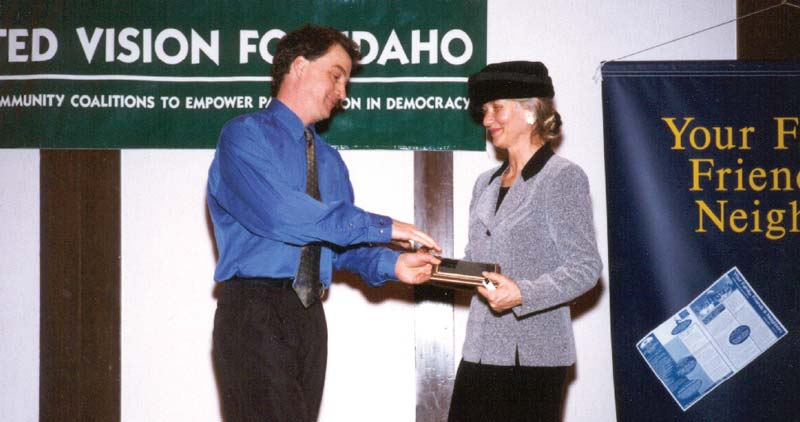From $10 to $100,000 in Four Years
With other organizations concentrating on cleanup at Hanford, MaryJane Butters made the decision to redirect the focus of Hanford Watch to the transportation of nuclear and other toxic waste, and then to local concerns about pesticide use, which ultimately led to a change in the way the organization approached environmental issues, hence its new name and non-profit status, Palouse-Clearwater Environmental Institute. After growing its annual budget to $100,000 in four years, Butters passed the directorship of the Institute over to Tom Lamar, who to this day continues to guide and direct it, some 33 years later. It’s a thriving environmental organization that has impacted the community of Moscow, Idaho, in a million different positive ways and is a model organization for any community. With 13 people on staff, the Institute is home to an eight-acre Nature and Learning Center (complete with a living roof, geo-web retaining walls, and a straw-bale bicycle pavilion) and is a local hub for everything “people, place, and community.”

Palouse-Clearwater Environmental Institute Director Tom Lamar presents PCEI founder MaryJane Butters with the award “Idaho’s Progressive Businessperson of the Year.”
Building Community
The Institute’s community agriculture program focuses on consumer education and support of family farmers. “We do a lot of advocacy for locally produced food, and help people understand the added costs of buying from outside the community instead of adding value from within,” says Tom. The Institute has established a very popular community garden with plots rented by local people.
Adopt-a-Stream
“Everything we’ve done so far has been because the people in our community have said, ‘This needs to happen,’” said Tom. For example, in 1990, he recalls, “A lot of people were saying, somebody should do something about how polluted the creek that runs through our town was. So we started doing something about it. We started with annual cleanup projects and then we began an Adopt-a-Stream program and started organizing around that.” This was the origin of the Institute’s watershed restoration program, which has engaged church and school groups, civic service clubs like the Lions and Elks, and fraternities and sororities in hands-on restoration work. The program has also contributed to the local economy. “We buy from local nurseries, helping create a strong market for native vegetation. We hire local contractors and workers, and our budget for that program is close to $300,000.”
“Folks come out for community-service projects; at-risk-youth and others do something for their community and gain skills. They plant trees, install erosion control fabrics, and much more. They provide the labor and learn about the stream in the process. Most people in the past considered it a drainage ditch, but as people help and watch us re-open the flood plain and restore the creek to its natural meanders, the community places new value on the creek. Now there is interest in creating a linear park along the stream with trails and benches.”
In addition to restoring the natural flood plain and sinuosity of the stream, the Institute has installed wetland cells to handle wastewater from a treatment plant and biofiltration swales to treat stormwater from parking lots, roads, and houses. Eight acres of constructed wetlands now handle 5% of the city’s water-treatment flow, and the Institute monitors the outflow to measure its effectiveness at keeping nutrients and other contaminants out of the creek.
Citizen Involvement
“This work improves our quality of life and gives people a reason to want to live here and reinvest in the community. We have used community contributions to leverage outside funding from state and federal pollution prevention contracts. We’re also seeing policy shifts in our local government as people begin to recognize the value of the stream and its related resources. In the past, the city was concerned with flooding and would spend money each year deepening the channel. Now their values have broadened, and they are implementing a new stormwater management plan and erosion-control ordinance to protect the stream’s ability to handle those peak flows.”
Restoration and addressing non-point source pollution has been one of many projects the Institute has successfully taken on, but the Institute has a larger goal, exemplified in its work with school children. “Our work is to try to turn the projects we take on into community building exercises as well. In the long run, because we do most of our work utilizing volunteers and get people involved on an emotional level, it has the long-term benefit of being more sustainable. People become invested in the work,” Tom pointed out.
Although the organization’s focus has continued to evolve, the underlying purpose has been consistent, which is to increase citizen involvement in decisions that affect the environment. The Institute has grown into one of the most successful organizations in the region and serves as a model organization for any town anywhere.